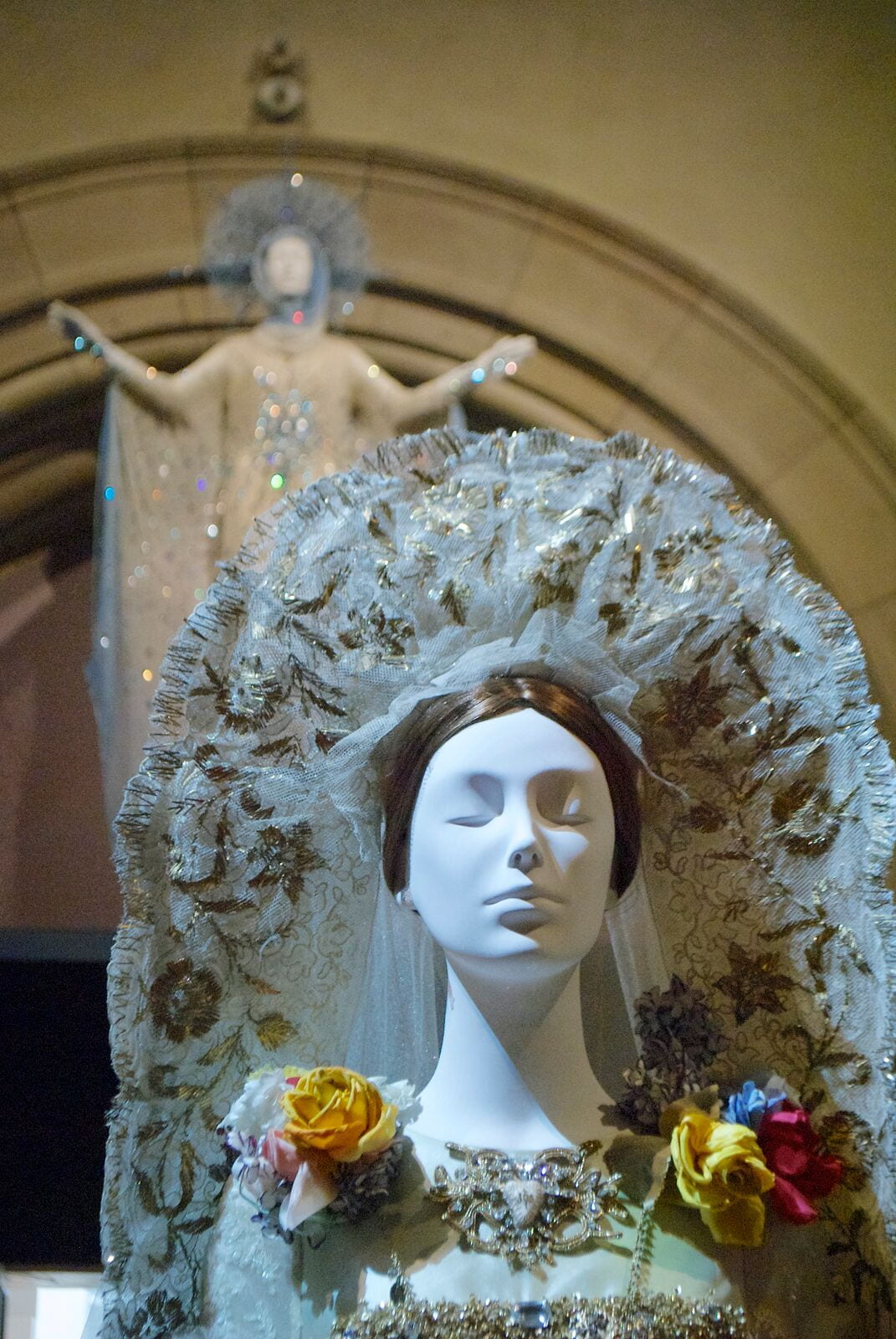
In the foreground: Christian Lacroix. Wedding ensemble, autumn/winter 2009-2010 haute couture. In the background: Thierry Mugler, evening dress, autumn/winter 1984-85. Photo: Cynthia Houng
By Contributing Writer Sarah Pickman
In his seminal work Fashion & Anti-Fashion: Exploring Adornment and Dress from an Anthropological Perspective, anthropologist Ted Polhemus delineates two broad styles of dress: fashion, characterized by constant – if often cyclical – change, and anti-fashion, characterized by deference to tradition and the status quo. For Polhemus, one of the quintessential kinds of anti-fashion is the garb worn by the members of particular religious sects or clergy: their garments, instantly recognizable and changing minimally over time, “state not only that ‘we’ exist, but they also express symbolically what kind of group it is that ‘we’ are.” It is perhaps not surprising then that the exhibition “Heavenly Bodies: Fashion and the Catholic Imagination,” organized by the Metropolitan Museum of Art’s Costume Institute, would tackle the intersections of fashion and anti-fashion through the use of religious garments and symbols as inspiration for secular, fashionable clothing. The exhibition – which is staged across both the Museum’s main building and The Cloisters, the Met’s satellite branch devoted to the art of Medieval Europe – probes the relationship between Catholic images, symbolism, and narratives and the work of a select group of fashion designers, many of whom were raised in the Roman Catholic faith. Unlike many previous Costume Institute exhibitions, “Heavenly Bodies” situates designer garments amongst objects from the Museum’s permanent collections, inviting comparisons between the religious imagery that suffuses European Medieval art and the twentieth- and twenty-first century garments that call on this tradition.
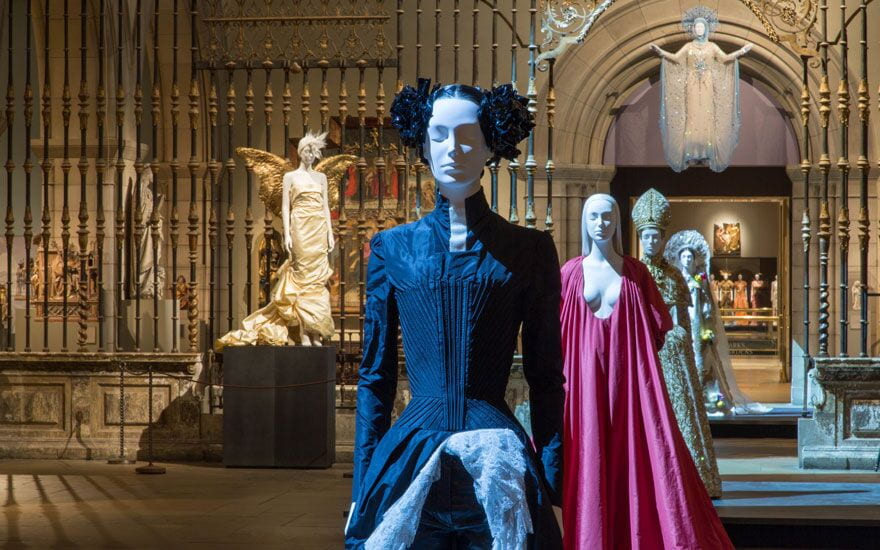
Haute couture dresses installed in the Met Fifth Avenue’s Medieval Galleries. Photo courtesy of the Metropolitan Museum of Art.
The central part of the exhibition is staged in the Museum’s Medieval galleries, where the work of designers such as John Galliano, Dolce & Gabbana, A. F. Vandevorst and others is interspersed amongst the permanent displays of tapestries, triptychs, and architectural embellishments from churches. While each ensemble is show-stopping in its own way, the connections between some of the garments and Catholicism seem a bit speculative; the curatorial labels relying more on an implied equation between Catholicism and opulence. (A flowing silk red Valentino gown, viewers learn from a label, “implies” the cappa magna robe worn by cardinals and bishops, but it might just as easily be, well, a flowing red silk gown.) The exhibition is more successful when it groups ensembles together to make clear the designers’ inspiration, as well invite comparison between how different designers interpret the same source of inspiration. This includes a row of feminine black garments that evoke the habits of Dominican nuns, and a second row of outfits inspired by the characteristic black cassock worn by male members of the Catholic clergy.
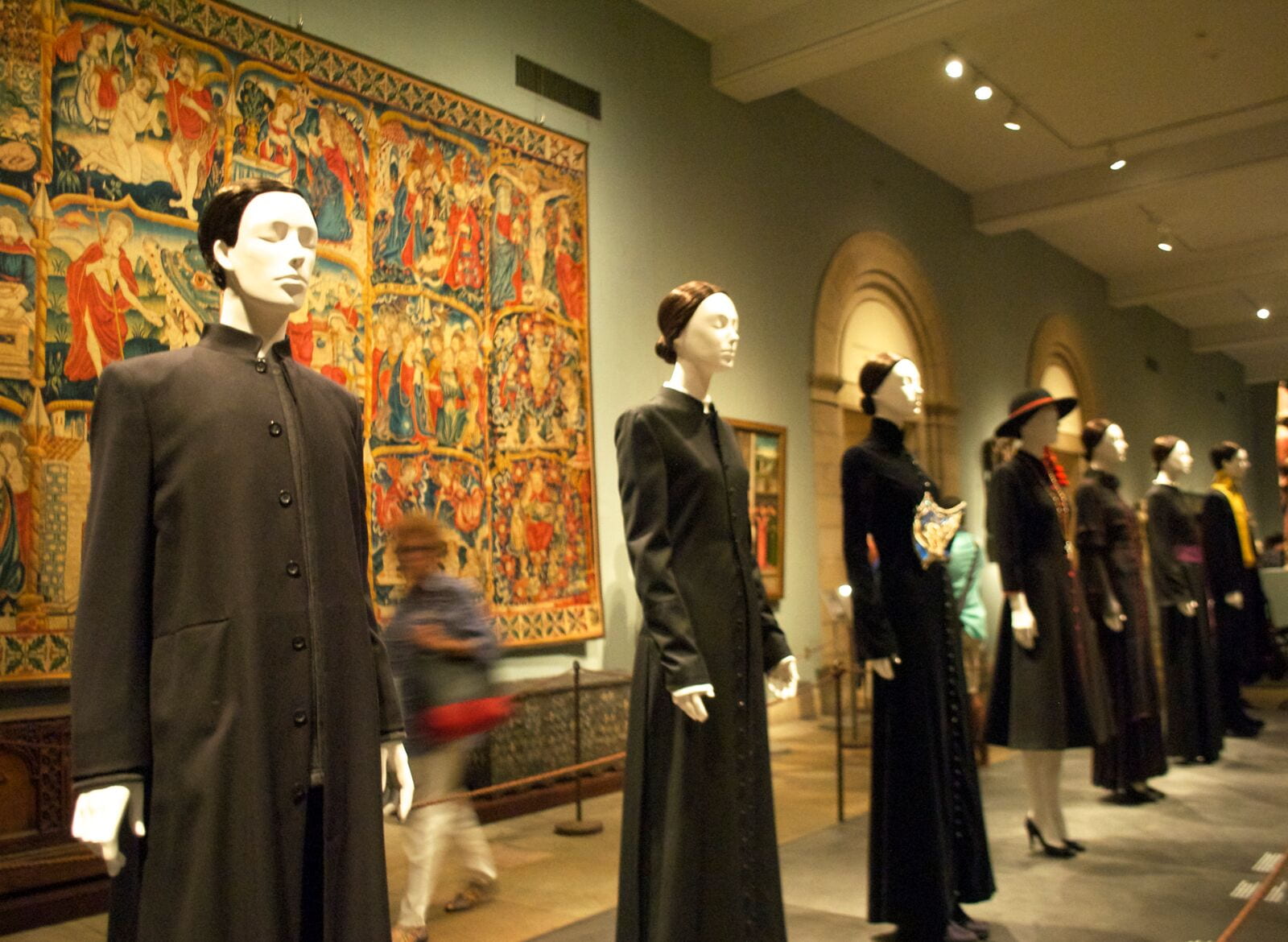
Designs inspired by clerical clothing worn by priests and other male members of the Catholic clergy. Photo: Cynthia Houng
The curatorial choice to stage this part of “Heavenly Bodies” in the permanent galleries – interspersing the designer garments with already-installed Medieval artwork – is ambitious, but it hits a few logistical snags. The Costume Institute’s special exhibitions are always popular, and the galleries feel visually crowded with so much of the open space now taken up with the fashion ensembles (and physically crowded when the extra visitors pour in). Certain components of the exhibition seem lost amidst all of the things on display. For example, several of the labels reference the satirical “ecclesiastical fashion show” scene in Federico Fellini’s 1972 film Roma, but the television monitor that shows this scene is tucked in an easily overlooked corner.
New temporary labels on some of the Medieval artworks discuss how Catholic vestments have changed or remained continuous over time, referencing depictions of the clergy in these works from the Middle Ages and their connections to the designer fashions nearby. However, as a historian and non-Catholic I wanted a more central text panel or panels with an overview of how some characteristic Catholic vestments arrived at their modern forms, becoming so standardized that they could serve as inspiration for couturiers. However, this historical context is discussed in greater detail in the exhibition’s accompanying catalogue. (More historical context would have also been helpful for emphasizing that the exhibition focuses on the Roman Catholic tradition, especially since some of the designer garments are displayed in adjacent galleries devoted to Byzantine art and Eastern Orthodox religious objects.) Two of the most breathtaking outfits in this section of the exhibit do evoke a sense of movement over time, even though they were never intended for human wear: stunning ensembles designed by Yves Saint-Laurent and Ricardo Tisci for statues of the Madonna in churches in France and Italy, respectively. Saint-Laurent and Tisci’s gowns and headdresses are recent iterations of the longstanding tradition of dressing statues of Mary in luxurious clothes, modern couture additions to a centuries-old Catholic practice.
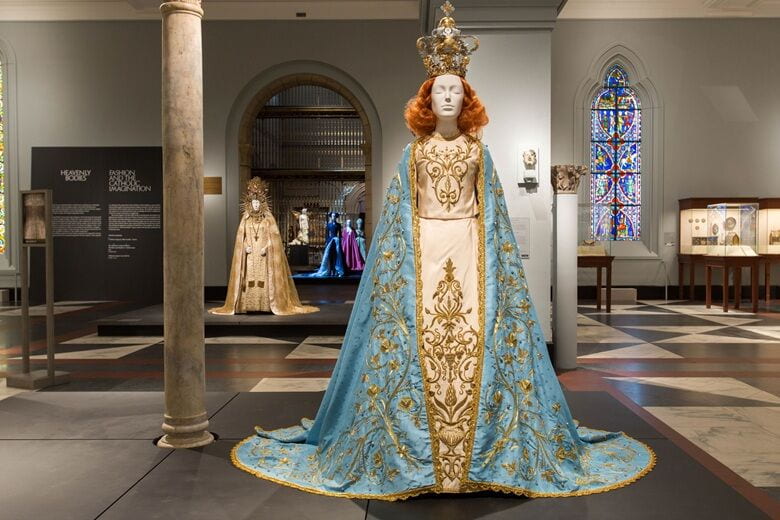
In the foreground: Riccardo Tisci, the Poor Benedettine Cassinesi Nuns of Lecce Statuary Vestment for the Madonna Delle Grazie, 2015 (original design, 1950). In the background: Yves Saint Laurent, statuary vestment for the Virgin of El Rocío, c. 1985. Photo courtesy of the Metropolitan Museum of Art.
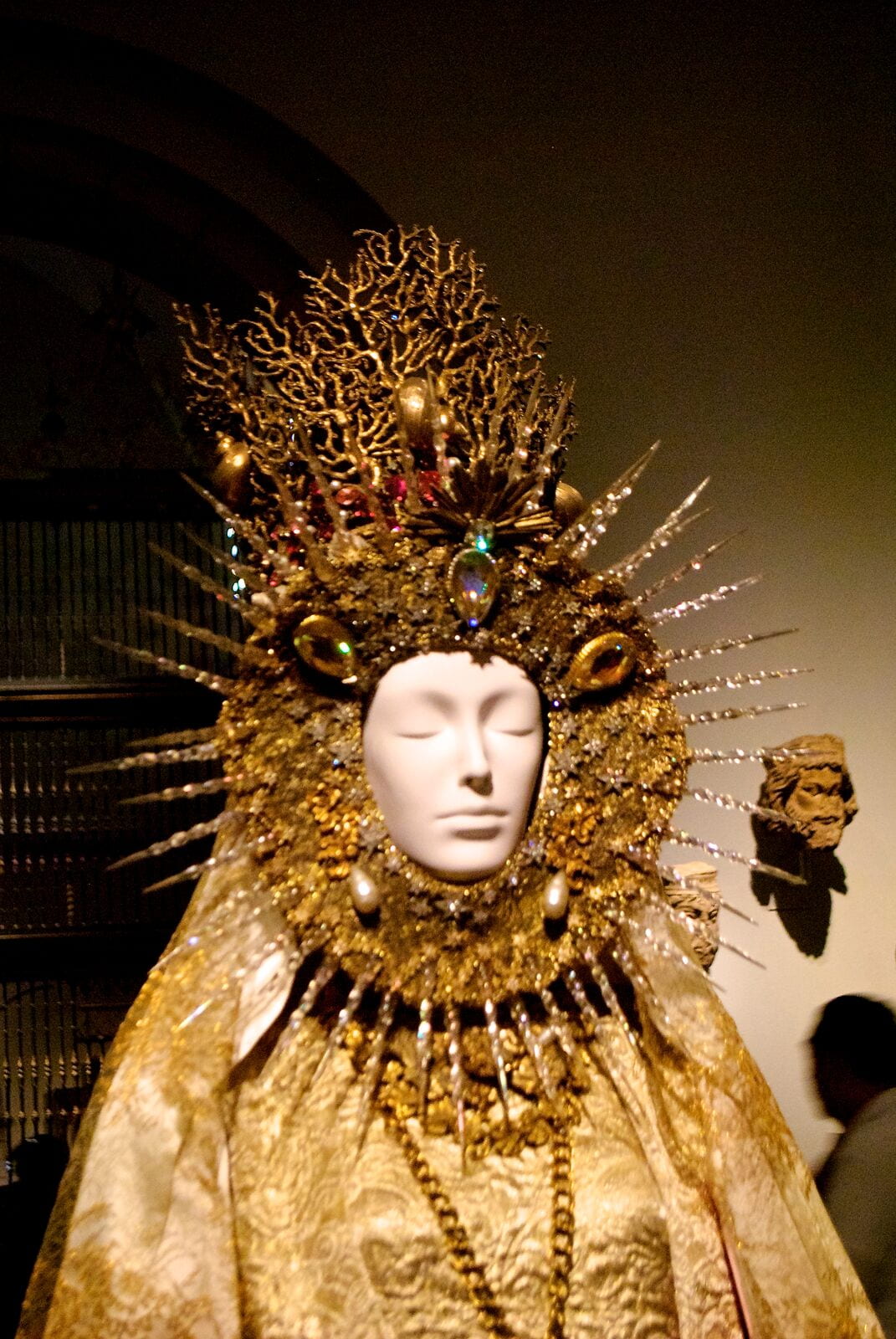
Detail of the Virgin of El Rocío’s headdress. Photo: Cynthia Houng
Some of the exhibition’s greatest highlights are not in these galleries on the Museum’s main floor, but downstairs in the Anna Wintour Costume Center galleries, where “Heavenly Bodies” continues. Here, visitors have the chance to see vestments and accessories on loan from the Sistine Chapel sacristy in Rome, some of which have never been on display outside of the Vatican. An introductory panel for these galleries makes explicit some of the exhibition’s overall themes. A quotation from Andrew Greeley’s The Catholic Imagination instructs us that Catholics live in an “enchanted world” of beautiful objects, each one a revelation of and reminder of the divine, while the words of noted Swiss theologian Hans Urs von Balthasar tell the viewer that Catholics “first perceive the mystery of God through beauty, not truth.” Such a sense of beauty and majesty is evoked in these galleries by a parade of dazzling ecclesiastical garments, most dating from the nineteenth and early twentieth centuries, each exquisitely embroidered and most embellished with gold and silver thread. One particularly beautiful cope (a long clerical cloak, open in the front and secured with a brooch) features Biblical scenes embroidered in such an extraordinarily lifelike way that another visitor asked me if the images had been painted on the ground textile. One side room is filled with a series of clerical accessories, including miters, scepters, and brooches, each covered in a stunning array of precious gemstones that sparkle in the low light of the gallery.
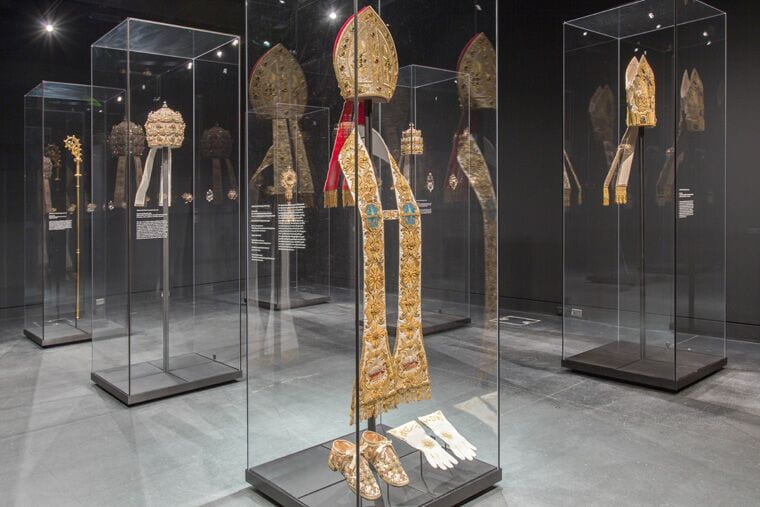
Installation view, Anna Wintour Costume Center galleries. Photograph courtesy of the Metropolitan Museum of Art.
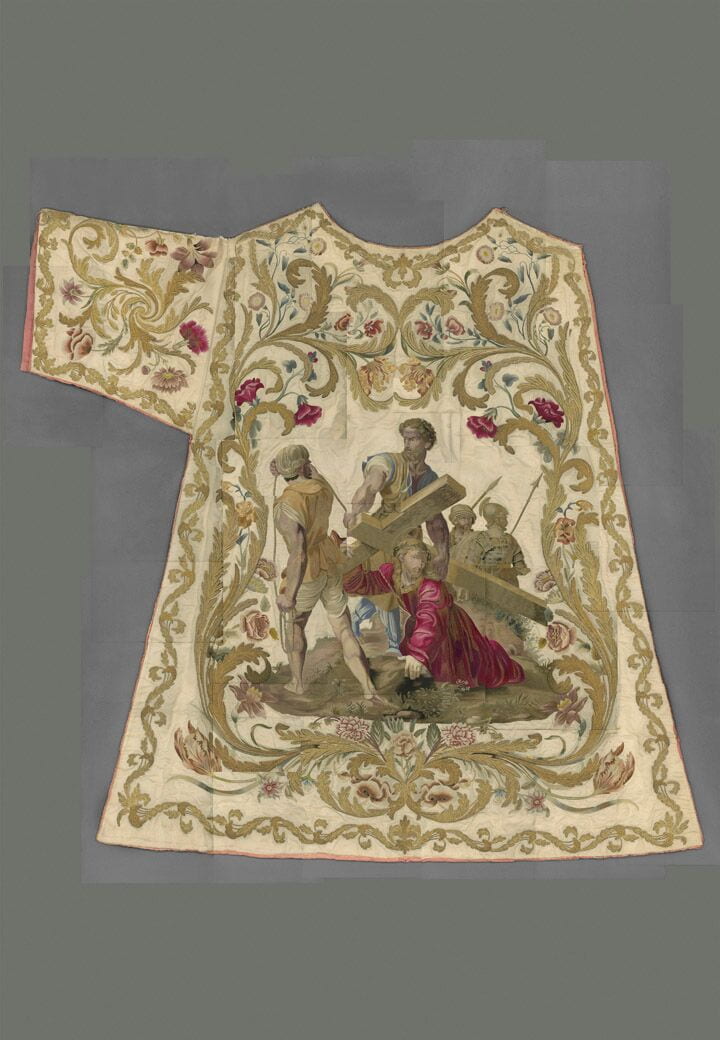
Dalmatic (front) of Pius IX (r. 1846–78), 1845–61. Italian. Courtesy of the Collection of the Office of Liturgical Celebrations of the Supreme Pontiff, Papal Sacristy, Vatican City. Digital composite scan by Katerina Jebb. Image courtesy of the Metropolitan Museum of Art.

Tiara of Pius IX (r. 1846–78), 1854. German and Spanish. Courtesy of the Collection of the Office of Liturgical Celebrations of the Supreme Pontiff, Papal Sacristy, Vatican City. Digital composite scan by Katerina Jebb. Image courtesy of the Metropolitan Museum of Art.
The labels in this section of the exhibition indicate that almost all of the loan pieces were originally gifts to the Vatican from various clerical orders or European monarchs. As someone not raised in the Catholic tradition, I was awed by the beauty and opulence of these objects. Seeing them up in person and up close, even behind glass, I understood how they evoked the splendor of God and his creation, and the glory that might await the believer in the afterlife. I also felt I understood how five centuries ago, such lavish gifts would have helped convince Martin Luther and other reformers of the Church’s decadence and its need for reform.
While many visitors may not want to make the extra trip to northern Manhattan to The Cloisters to see the third segment of “Heavenly Bodies,” the effort is well worth it. Here, the exhibition returns to designer fashion, staged again amidst a permanent collection of Medieval European artwork and architecture. At The Cloisters, the galleries are arranged thematically around particular artistic periods or architectural components, and the garments are likewise grouped to be in dialogue with each other and with each room, an approach I’d wished had been more prevalent in the Metropolitan’s main building. For example, the Fuentidueña Chapel, a transported Spanish Romanesque church apse, holds a series of dresses that evoke clothing worn for particular sacraments such as marriage and first communion. Nearby, the reinstalled Pontaut Chapter House, originally a daily meeting place for Aquitanian Benedictine monks, hosts a row of dresses designed by Valentino, Geoffrey Beene and Claire McCardell that in color and construction evoke the habits of certain monastic orders. Because of its location, The Cloisters is almost always less crowded than the main Metropolitan Museum building, allowing visitors the chance to view this section of “Heavenly Bodies” and its successful thematic groupings in a more unhurried manner.
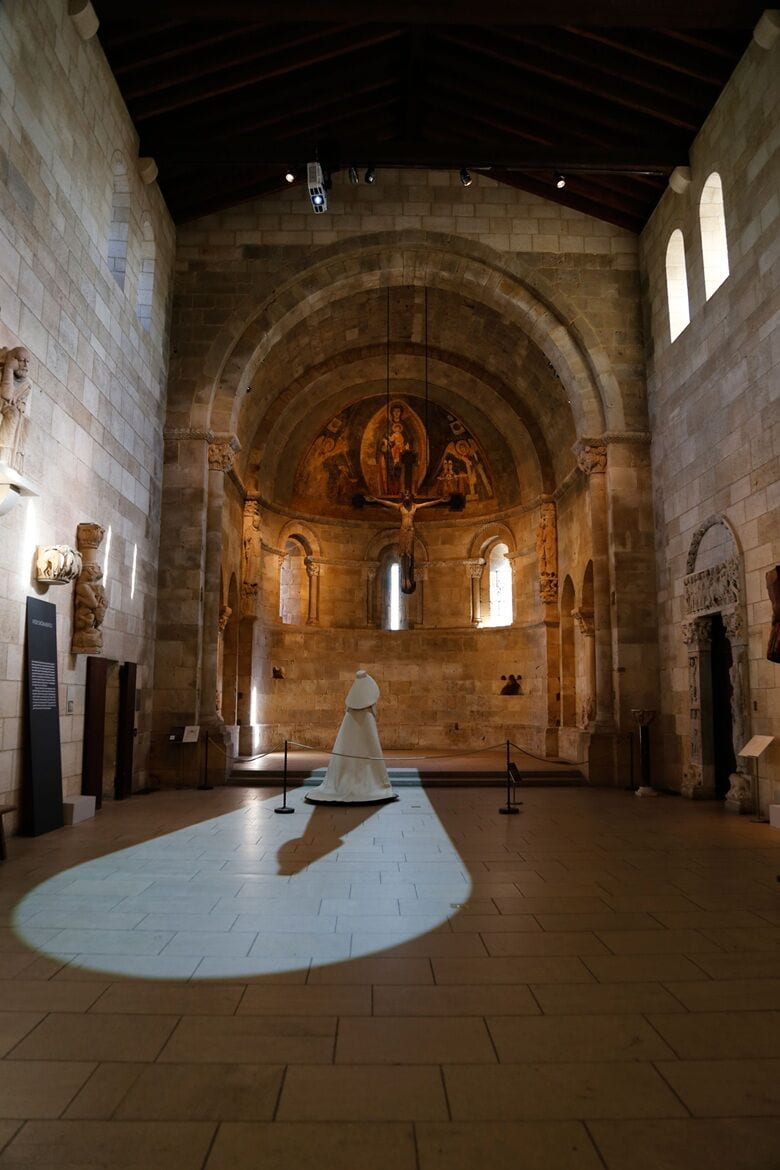
Installation view of an ensemble by Cristóbal Balenciaga for House of Balenciaga, wedding ensemble, 1967. Installed in the Fuentidueña Chapel, The Cloisters. Photograph courtesy of the Metropolitan Museum of Art.
The relationship between the Roman Catholic Church and clothing has many intriguing facets to explore: the evolution of ecclesiastical dress as part of a Catholic visual lexicon, the transgressions of erotic designer couture inspired by sacred symbols, the tension between clerical vows of poverty and opulent garb that evokes God’s beauty and majesty. If any museum has the collection, space, and financial resources (not to mention the clout to negotiate loans with the Vatican) to pull off an exhibit on this topic, it’s the Metropolitan Museum. And yet the subject itself is so vast and rich it’s difficult to probe all of these questions and provide deep historical context in a completely satisfying way, especially within the logistical limits of label panels and floor space. The involvement of the Church also likely hushed opportunities for critique: as another reviewer noted, many of the vestments are the result of hundreds of thousands of hours of handwork by nuns, whose exhaustive and essential labor for the Church in this capacity goes unquestioned. Overall, though, “Heavenly Bodies” is an ambitious and beautiful exhibit that speaks to the intriguing tensions between the fashion of elite modern designers and the anti-fashion of a millennia-old faith tradition.
“Heavenly Bodies: Fashion and the Catholic Imagination” is on display at The Metropolitan Museum of Art’s Fifth Avenue building and The Cloisters through October 8.
Sarah Pickman is a Ph.D. student in History of Science and Medicine at Yale University. Her research centers on American and British exploration, anthropology, and natural history museums in the long nineteenth century, with a focus on the material culture of expeditions, particularly in the exploration of the Arctic and Antarctica. She holds a B.A. in Anthropology from the University of Chicago and an M.A. in Decorative Arts, Design History, and Material Culture from the Bard Graduate Center of Bard College.



Leave a Reply